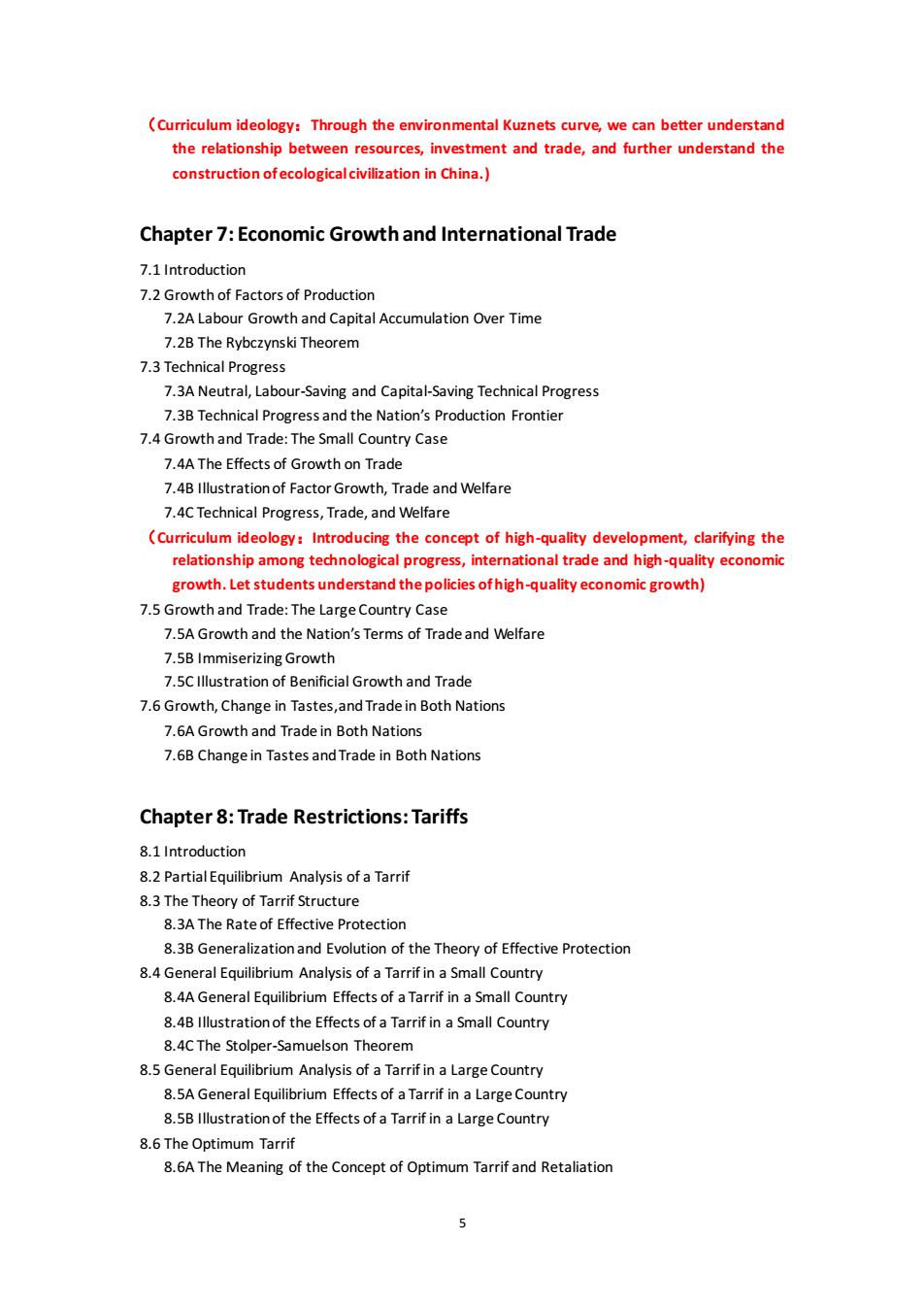正在加载图片...

(Curriculum ideology:Through the environmental Kuznets curve,we can better understand the relationship between urces,investment and trade,and further understand the construction ofecologicalcivilization in China.) Chapter 7:Economic Growth and International Trade 7.1 Introduction 7.2Growth of Factors of Productior 7.2A Labour Growth and Capital Accumulation Over Time 7.2B The Rybczynski Theorem 7.3 Technical Progress 7.3A Neutral,Labour-Saving and Capital-Saving Technical Progress 7 38 Tec 7.4Gr The Small Country Case 7.4A The Effects of Growth on Trade 7.48 Illustration of Factor Growth.Trade and Welfare 7 AC Technical progress Trade and welfare (Curriculum ideology:Introducing the of high- e and high-qu growth.Let students understand thepolicies ofhigh-qualityeconomic growth) 7.5 Growth and Trade:The Large Country Case 7.5A Growth and the Nation's Terms of Trade and Welfare 7.5B Immiseri ne Growth th and trade 7.6Growth,Change in Tastes,and Tradein Both Nations 7.6A Growth and Trade in Both Nations 7.6B Change in tastes and Trade in both nations Chapter 8:Trade Restrictions:Tariffs 8.2 Partial Equilibrium Analysis of a Tarrif 8 3 The theory of tarrif Structure 8.3A The rate of Effective protection 8.4General Equilibrium Analysis of a Tarrifin a Small Country 8.4A General Equilibrium Effects of a Tarrif in a Small Country 8.4B Illustration of the Effects of a Tarrif in a Small Country 8 AC The Stolner.Samuelson Theorem .General Equiibrium Analysis of Large Country 8.5A General Equllibrium Effects of a Tarrif in a Large Country 8.5B lllustration of the Effects of a Tarrif in a Large Country 8.6The Optimum Tarrif 8.6A The Meaning of the Concept of Optimum Tarrif and Retaliation5 (Curriculum ideology:Through the environmental Kuznets curve, we can better understand the relationship between resources, investment and trade, and further understand the construction of ecological civilization in China.) Chapter 7: Economic Growth and International Trade 7.1 Introduction 7.2 Growth of Factors of Production 7.2A Labour Growth and Capital Accumulation Over Time 7.2B The Rybczynski Theorem 7.3 Technical Progress 7.3A Neutral, Labour-Saving and Capital-Saving Technical Progress 7.3B Technical Progress and the Nation’s Production Frontier 7.4 Growth and Trade: The Small Country Case 7.4A The Effects of Growth on Trade 7.4B Illustration of Factor Growth, Trade and Welfare 7.4C Technical Progress, Trade, and Welfare (Curriculum ideology:Introducing the concept of high-quality development, clarifying the relationship among technological progress, international trade and high-quality economic growth. Let students understand the policies of high-quality economic growth) 7.5 Growth and Trade: The Large Country Case 7.5A Growth and the Nation’s Terms of Trade and Welfare 7.5B Immiserizing Growth 7.5C Illustration of Benificial Growth and Trade 7.6 Growth, Change in Tastes,and Trade in Both Nations 7.6A Growth and Trade in Both Nations 7.6B Change in Tastes and Trade in Both Nations Chapter 8: Trade Restrictions: Tariffs 8.1 Introduction 8.2 Partial Equilibrium Analysis of a Tarrif 8.3 The Theory of Tarrif Structure 8.3A The Rate of Effective Protection 8.3B Generalization and Evolution of the Theory of Effective Protection 8.4 General Equilibrium Analysis of a Tarrif in a Small Country 8.4A General Equilibrium Effects of a Tarrif in a Small Country 8.4B Illustration of the Effects of a Tarrif in a Small Country 8.4C The Stolper-Samuelson Theorem 8.5 General Equilibrium Analysis of a Tarrif in a Large Country 8.5A General Equilibrium Effects of a Tarrif in a Large Country 8.5B Illustration of the Effects of a Tarrif in a Large Country 8.6 The Optimum Tarrif 8.6A The Meaning of the Concept of Optimum Tarrif and Retaliation